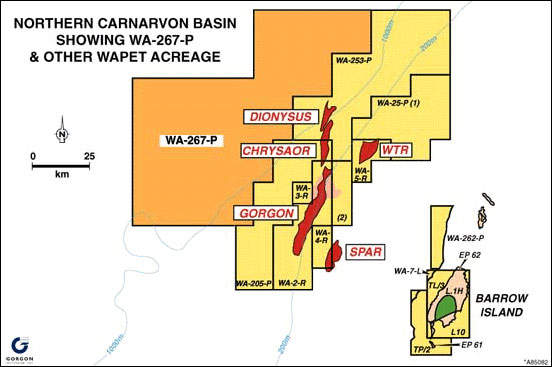The Gorgon gas fields are located offshore Western Australia, approximately 60km from Barrow Island and 200km west of Dampier. Five fields have so far been discovered, namely Gorgon, Chrysaor, Dionysus, West Tryal Rocks and Spar. Collectively called Greater Gorgon, these fields have been extensively appraised, including the eight Gorgon wells.
The field is being developed by the Gorgon Venture, a joint venture of ChevronTexaco, Shell and ExxonMobil. ChevronTexaco, with a four-seventh interest, is the operator of the Gorgon development on behalf of the Gorgon Venture.
First gas from the field was produced in March 2016. Chevron entered supply agreements for four million tonnes of natural gas a year with Osaka Gas, Tokyo Gas, GS Caltex, Chubu Electric and Nippon Oil Corporation.
Gorgon discovery
Gorgon was discovered in 1980 following a discovery in West Tryal rocks by West Australian Petroleum (WAPET) in 1973. In 2000, Chevron acquired all the assets of WAPET.
3D seismic surveys have been completed for all the fields in the Greater Gorgon area and for the three largest reservoir-simulation models, which have been fully developed.
Gorgon oil reserves
Up to 13.8 trillion cubic feet of hydrocarbon reserves were certified as proven in the Greater Gorgon area. This includes 9.6 trillion cubic feet of proven hydrocarbon reserves in the Gorgon field, which is enough for a two-train LNG project.
Proven plus probable reserves in the Greater Gorgon area exceed 17.6 trillion cubic feet, with certified possible reserves increasing that total to 40 trillion cubic feet. The proven reserves in the Greater Gorgon area are the energy equivalent of 6.7 billion barrels of oil. Its raw gas contains 12%-15% carbon dioxide.
Gorgon field development
Chevron is implementing a phased subsea development of the Gorgon field, starting at North Gorgon. Subsea wells are tied back to a gravity-based platform located in the shallower water depths to the east of the field. The gas is processed on the platform prior to export via the trunkline to the LNG plant site in the Burrup Peninsular.
The current greenfield Gorgon LNG plan is based on three liquefaction trains, each capable of producing 15 million tonnes a year. The $50bn LNG plant was approved by the Environmental Protection Authority in August 2009. Groundbreaking for the LNG plant took place in December 2009.
The LNG plant became operational in March 2016, but was closed down subsequently due to technical problems. The facility resumed its operations in May 2016.
Processing
Carbon dioxide contained in the natural gas produced from the field is removed to avoid freezing in the LNG process. Instead of venting the carbon dioxide into the atmosphere, it is injected into the Dupuy saline reservoir below Barrow Island.
Re-injection of carbon dioxide is equivalent to removing over 630,000 cars annually off roads in the US.
Gorgon contracts
In May 2008, GE’s Oil & Gas drilling and production division was contracted to supply subsea equipment for the Gorgon field. Under the five-year contract GE supplied VetcoGray manifolds, subsea trees, wellheads and other equipment. The company provided pipeline termination equipment, production control systems, and installation and operational support.
In October 2009, GE won a $400m contract to provide its advanced LNG technology for the production of gas from the Gorgon field. GE supplied LNG refrigeration and carbon dioxide reinjection equipment, including three refrigerant compression trains and six compression trains. GE was awarded a new contract in March 2010, bringing its total contract value to $1.1bn.
Aker Solutions was awarded a contract for providing 264km of steel tube umbilicals for the Gorgon field. The umbilicals link the subsea production system of the field with the LNG plant on Barrow Island.
In July 2011, CB&I received a $2.3bn contract to perform mechanical, electrical and instrumentation work for the project. Subsea 7 was awarded a $440m contract to install and tie in heavy-lift units in the Gorgon and Jansz fields.
In 1998, a consortium of Clough Kvaerner and Schlumberger was awarded the contract to design offshore infrastructure for the Gorgon project.








